Part 1 - By Steve Dwyer
 At the start of 2020, Rick Shoyer III assumed the role as president of the Brownfield Coalition of the Northeast (BCONE). He has been a BCONE member for over seven years. No sooner did he take the reins that the association -- along with the entire world -- was hurled into an unprecedented crisis with the onslaught of the COVID-19 pandemic.
At the start of 2020, Rick Shoyer III assumed the role as president of the Brownfield Coalition of the Northeast (BCONE). He has been a BCONE member for over seven years. No sooner did he take the reins that the association -- along with the entire world -- was hurled into an unprecedented crisis with the onslaught of the COVID-19 pandemic.
Months later, Shoyer -- along with the BCONE board and the membership -- is assessing the impacts of the COVID-19 era and trying to determine how it will continue to affect BCONE going forward. This would include the way workshops and live networking might have to yield to a greater reliance on remote conferencing, and how it would be embraced by members.
The investigation and remediation expert who’s classified as a Licensed Site Remediation Professional (LSRP) and N-2 Industrial Operator in the State of New Jersey, received his BS in Engineering from Michigan State University, East Lansing, Mich., in 1982, and has spent the past 35-plus years investigating and remediating organic and inorganic substances both in-situ and ex-situ.
Following is a question and answer session with the 2020 BCONE President, who says he’s eager to build on the organization’s long and sustained accomplishment record in several ways, including potentially expanding the BCONE footprint geographically to engage with more practitioners.
Within the aegis of LSRP in NJ, Shoyer hopes to continue on a mission to make the New Jersey permitting process even more streamlined than it has become—one solution being to more acutely streamline the self-reporting and self-approval process. CT and MA, two other states in the BCONE footprint, have similar but more mature licensed professional programs.
Q: As president of BCONE, what is the three- to five-year vision you have outlined pertaining to the organization as a whole, as well as some necessary steps to push the needle forward on efficient operations—and championing brownfield redevelopment across the BCONE footprint?
A: The organization has been established over a long period of time with a great history that covers a broad spectrum geographically. We are looking to build on these accomplishments, perhaps expanding geographically, to engage more holistically with activities, say, across western Pennsylvania and regions of New England. The nucleus of BCONE has been New Jersey, New York City, the Philadelphia, PA greater metro area, southern New York state and Connecticut. One mission is to see several BCONE member states—take Delaware for example—independently sponsor more programs, workshops and other events in the future. We strive to be a resource on policies, procedures and programs that affect sustainable and resilient redevelopment of blighted areas at the individual state level and share the success across our regional area.
Q: How has the LSRP program evolved over the past eight to 10 years, in your estimation? And, what can be done to streamline the process across timeframes, cost containment, capital generation assurance, compliance and more?
A: We still have bottlenecks with, let’s say, permitting issues. BCONE and other organizations are providing input to the Department, which is looking into revamping the permitting process to better emphasize self-reporting and self-approvals—to separate the less complicated permits (sites) from the more complicated ones—all in all to better streamline this process. Some of the issues are regional in scope and scale across the state.
Q: Were there any so-called “unlikely” outcomes that manifested from the LSRP program’s implementation over the years.
A: One of the biggest positives that came of out of the program was it put my competitors on a different platform, it provided a different reason to work together for the common good. I am able to share ideas with many talented competitors on a professional level, and that’s been refreshing. So the entire environmental professional community improves through shared knowledge, professionally we all become better and more consistent.
There’s also been more quality dialogue with state regulatory and legislative officials, more of a mission to find common ground. We still have issues to move along within the concept of timing for the Department to request additional investigations (samples). Is the additional sample necessary to demonstrate the remedy is actually protective of human health and the environment? Thankfully, in the majority of cases taking an additional soil or groundwater sample has not changed a remedy outcome. It has only led to adding costs or delaying closures. But as the program has matured, and LSRP’s and regulators share expectation and concerns, it has helped lessen the ‘micro-management’ of environmental work.
Because BCONE is a regional organization, the NJ LSRP program has been able to learn from the MA and CT programs. We are in regular communication with the professional organizations in those states and regularly exchange information.
Q: In the months following the start of the COVID-19 pandemic, how has the BCONE operating vision been re-focused, re-calibrated during a “new normal” phase where priorities will be inevitably shifting?
A: Developers build in the urban infill for a number of reasons, with one being leveraging the walkability of cities through project visions. How will this change now and in the future? The close quarters of cities has become a potential health concern. One attraction for many was the small shops and restaurants with housing above. Did/will these small boutiques and restaurants survive? If not, the desire to live in a neighborhood with empty shops and store fronts decreases dramatically. The question is, what percentage of millennials and Gen X,Y and Z will still opt to live in the city [perhaps leaving due to higher rents and more open space of suburb/exurbs]? It is shifts like these that are certain to be disruptors. If you look at a TOD-oriented project, it’s very much tied to the concept of promoting ‘walkable cities.’ But the other essential component is the public transportation piece, which is a backbone of these projects. Will once ‘power-users’ of public transportation establish a level of confidence and trust in rising trains and busses again, from a health and safety standpoint?
Q: Following up on repercussions of the COVID-19, can you talk about how things might change in the context of BCONE-sponsored events and workshops?
A: The main draw was live conferences, the personal interactions that are important in business and all relationships. The drawback on these are travel time and expenses, so they generally are well attended locally, and difficult to reach across a larger regional coverage that BCONE has. Now due to travel restrictions, conferences will have to be remote—and for how long? But as an unexpected positive development, I think [the pandemic] we might see more robust attendances in the virtual world and across more BCONE member states, who might not have been inclined to travel to, say, New Jersey or New York for an event. But they can now participate in a virtual workshop, saving time and travel expenses. This allows BCONE to truly reach across a larger geographic territory.
Q: How do you see conducting business in a virtual world being accepted holistically?
A: Polling our vendors and exhibitors they are 180-degrees apart. You have ones who depend on live events, like to interact with business associates face to face—this new virtual world might be harder for them to adapt to. On the other hand, we have member companies who thrive in a virtual conference or workshop setting. The advances in technology has evolved over the last few years, making this virtual platform much easier to pull off. If the pandemic had occurred 10 years ago, this would have been a huge challenge to pull off.
Q: We can’t seem to shed questions about the pandemic and the different ways it impacts BCONE members. How about the way business is progressing in their engagement with state, county and local governments?
A: Looking at permitting and municipal approvals, I think that for a number of our members permit reviews and approvals have actually gone smoother, with faster turnaround times because municipal staffs have had fewer meetings. As a result, they have been able to push through permitting approvals. I’ve been very pleased with the responses from members on that subject. I’m sure there are others that have the opposite experience.
Q: How about the impact on project financing, securing capital?
A: On the capital financing front, there’s a notion that a percentage of projects might have been halted due to loans being put on hold. I see it more as projects possibly being delayed—or modified—for other extenuating reasons. A developer might now be weighing whether the ambitious mixed use residential/commercial project is now economically feasible. The small business got hit hard with the pandemic and store closings. No one wants to live above empty store fronts. There’s a synergy between the commercial footprint and the residential component of a development. That co-relationship will now be put more to the test.

